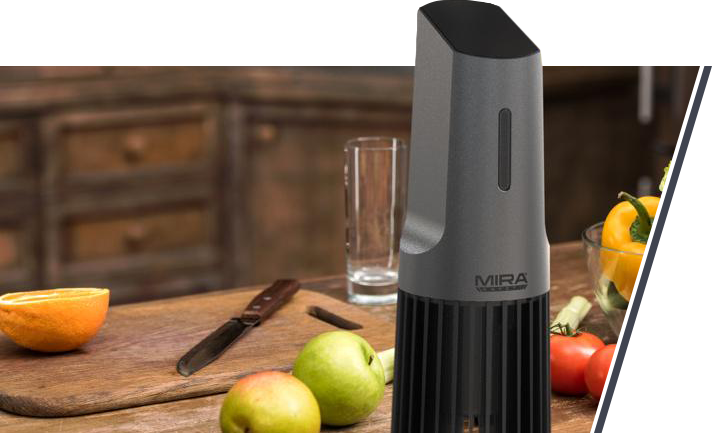Atrazine is the second most widely-used pesticide in America, with 76 million pounds applied on crops across America each year.
And it’s also banned in 35 countries (including the European Union) as a known hormonally active agent or “endocrine disruptor.” It’s able to chemically castrate frogs even in minuscule doses, and it’s one of the most commonly found contaminants in a wide variety of groundwater tests.

(Image source: Image courtesy of Southern Agriculture)
Much like glyphosate (another popular pesticide Jamie Jung has written about HERE), Atrazine is overused and poorly managed in industrial agriculture. This can lead to much higher-than-intended levels of exposure which some studies have linked with health issues ranging from tumors, leukemia, and lymphoma to breast, ovarian and uterine cancer.
Both the American Environmental Protection Agency (EPA) and the World Health Organization (WHO) remain firm in their stance that Atrazine has NOT been proven to cause cancer—but the proven impact of the pesticide’s use has already been enough for dozens of governments to prohibit its use. The EPA still classifies the compound as “moderately toxic.”
Today, we’re going to look deeper at Atrazine, what it’s done for America’s agriculture, and the potentially devastating effects it could have on your family.
Table of Contents
-
01
What is Atrazine?
-
02
Atrazine in Drinking Water
-
03
Atrazine and Wildlife
-
04
Does Atrazine Cause Cancer?
-
05
Effectively Banned in 35 Countries
-
06
Taking Legal Action
-
07
Tips for an Atrazine-Free Household
-
08
Keeping Your Family Safe
What is Atrazine?
Pure Atrazine is an odorless white powder that isn’t particularly reactive, flammable or volatile. It’s sold and transported either as a concentrated emulsion, a powder, or a granulated product.
Atrazine is also water-soluble—a critical defining feature in terms of its advantages and dangerous impact on our health & environment …
Since it’s water-soluble, it’s easy to transport, manipulate, and spray across massive acreage of crops. But that same water solubility means it can easily leach through the topsoil and into reservoirs, groundwater and other aquatic environments. It can also affect a variety of plants and animals that weren’t the original target.
Once absorbed by plants, Atrazine inhibits the process of photosynthesis to starve them out. Atrazine excels at preventing weeds across vast fields of cash crops, including everything from corn and soybean to sugarcane and even turf (including some residential lawns).
-

60% of America’s corn …
-

75% of our sorghum …
-

90% of sugarcane …

(Image source: Image courtesy of Center for Food Safety)
A 2009 study found that it was also commonly used at Christmas tree farms. The primary producer of Atrazine in Canada, Australia and the United States is Syngenta. Syngenta is a multinational conglomerate headquartered in Basel and owned by Chinese state-owned ChemChina.
For farmers, the herbicide’s appeal is in its cost-effectiveness.
The manufacturer claims it can boost yields and deliver an estimated $28/acre advantage over other herbicides. They claim it helps to save consumers upwards of $6.2 billion on grocery expenses each year—contributing to lower prices for meat, eggs, dairy, and ethanol.
Independent studies have confirmed Syngenta’s claims. One long-term university study from 1986-2005 found that the average corn field yielded 5.7 more bushels per acre where Atrazine was used.
But while the manufacturer hails Atrazine as an agricultural miracle, others aren’t so sure …
Atrazine in Drinking Water
Atrazine has been consistently detected in numerous bodies of water all over the world.
Research estimates that approximately 1-6% of the herbicide ends up in our water. It’s the most commonly-detected contaminant by a massive margin—10 to 20 times more common than any other threat.
Water tests have routinely hit upon atrazine levels that could potentially be dangerous for infants, small children and other vulnerable parties. One article in the New York Times estimated that 33 million Americans had been exposed to Atrazine through their taps and faucets.

(Image source: Image courtesy of Harvard Health)
Atrazine most often enters the environment through typical runoff, manufacturing, transport, and improper disposal. Since it’s widely used all across the United States on a variety of staple crops,
With an exceptionally lengthy half-life of 95-350 days, it can spread further and remain in higher concentrations longer than many waterborne contaminants. Normal runoff typically persists for 8-60 days. If and when Atrazine reaches the water table, it can remain for up to 1-2 years.
Fortunately, it still won’t spread especially far—with the highest frequency of health issues localized around the actual farms that use Atrazine themselves. Nevertheless, it’s essential to be mindful of your water sources and know where your drinking water comes from.
You can also test your home tap water using an assay kit like those available on Amazon. These kits often come with various colored strips to test for different contaminants. Search for Atrazine, and you should see a few options.
If your home’s water source tests positive for Atrazine, you might consider switching to bottled water.
Bottled water isn’t the most environmentally-friendly option, but it can be a practical way to keep your family safe when your other options are limited. Here are some of the safest brands you can count on:
PULL BOX: The 4 Safest Brands of Bottled Water
1.Nestle Pure Life: This spring water is the flagship offering of the world’s largest food and beverage company. It’s purified and tested under the strictest standards, making it an easy choice for your family.
2.Fiji: The famous brand in the square bottle is artesian, meaning that it’s pumped out of deep underground reserves unlikely to be polluted by pesticides like Atrazine. It’s also tested to meet strict regulations for quality.
3.Glaceau Smart Water: While it starts out much the same as regular tap water, Glaceau goes through an intense purification process before it’s mineralized and later sold to you. 4.Evian: The classic French brand still comes out on top. The company publishes annual water quality reports, so you know exactly what you’re getting. Many of these brands offer larger bottles and 1- or 5-gallon jugs which can help you cut down on waste. During one study in 2010, University of California at Berkley (UCB) scientists exposed 40 male tadpoles to water with Atrazine at just 2.5 parts per billion—well within the EPA’s established limits for drinking water. Roughly 10% became “functionally female” in short order, according to the study. While these frogs were still capable of reproducing, they were still genetically male—so their only possible offspring was more male frogs. In addition to that, 75% of the remaining frogs exposed to Atrazine were effectively chemically castrated and unable to reproduce at all. “These kinds of problems, like sex-reversing animals skewing sex ratios, are much more dangerous than any chemical that would kill off a population of frogs,” explained UCB’s Tyrone Hayes, the scientist responsible for the findings. Atrazine exposure doesn’t kill these frogs, but it can have a lasting impact that irreversibly damages a gene pool and its entire ecosystem. More recent UCB studies found that native leopard frogs (Rana pipiens) showed signs of atrazine exposure up to 1,000 miles away from areas where the pesticide was applied. (Image source: Image courtesy of National Parks Service) Atrazine’s manufacturer, Syngenta, aggressively disputes these findings. To which Hayes responds, “when you have studies all over the world showing problems with atrazine in every vertebrate that has been looked at – fish, frogs, reptiles, birds, mammals – all of them can’t be wrong.” In other words—that would be a whole lot of smoke … without any fire. This ultimately begs the question … Atrazine belongs to a class of compounds called triazines, all of which have been proven to cause cancer in laboratory rats. And while both the EPA and the WHO deny any link between Atrazine and cancer, there are studies from several rural Kentucky counties that argue otherwise. Remember, Atrazine is an endocrine disruptor. So atrazine effect on humans is well defined. It’s believed the herbicide may increase the incidence of tumors by disrupting those endocrine-signaling pathways. It can increase the conversion of testosterone into estrogen, increasing the risk of breast cancer for women. (Image source: Image courtesy of EpThinkTank) Moreover, Atrazine uses the same aromatase pathways used by a popular class of breast cancer drugs (aromatase inhibitors). As a result, Atrazine can decrease the effectiveness of these drugs. It can also increase the rate of cell proliferation in existing tumors—meaning that those women already suffering from breast cancer are potentially the most vulnerable to atrazine exposure. Atrazine’s ability to interfere with normal hormonal function also makes it dangerous in terms of reproductive health. By mimicking the hormones produced at various cycles of pregnancy, it’s believed to be linked with preterm births and other common issues. But despite dozens of studies showing the adverse health effects of atrazine exposure, authorities (along with Atrazine’s manufacturer Syngenta) claim there’s still just not enough conclusive evidence to say with certainty that Atrazine causes cancer. Given that Atrazine is worth billions of dollars in business each year, it seems baffling (if not maddening) that this single and extremely important question remains unanswered. At the same time, those types of comprehensive studies are hardly forthcoming. As you’ll see in a moment, the EPA actually had to be taken to court to ensure they’d evaluate the dangers of potential exposure. Atrazine’s consistent spread through the water supply is the primary reason it isn’t used anywhere in Europe. Syngenta’s public relations team fervently insists it’s not strictly banned or on any list of “forbidden” compounds. But its persistence in groundwater samples led the European Commission (EC) to discontinue the herbicide’s use in October of 2003—the same month the EPA renewed its registration. The EC cited its “long-term persistence in the environment, together with toxicity for wildlife and the possible link to effects on human health,” as its cause. (Image source: Image courtesy of Energy Intelligence) The decision was the first action ever taken against endocrine-disrupting compounds by European authorities. While many view this as a serious step in the right direction, others point to the fact that Syngenta—a company headquartered in the EU—is making billions each year off a product that can’t even be used in its home country. Some American farmers have begun to follow suit, switching from Atrazine to safer and more organic weed killers. But without a prohibition or a serious shift in incentives, it’s unlikely the rest of the industry will follow suit anytime soon. Syngenta has also been busy in court—defending itself from various class action lawsuits going back over a decade. While the company fervently denied all wrongdoing, it still agreed to pay out $105 million to reimburse more than a thousand water systems throughout the United States for “the cost of filtering atrazine from drinking water.” A few years later, in 2015, Canada’s Pest Management Regulatory Agency (PMRA) began a product review. Instead of setting a strict limit on Atrazine in water levels, the PMRA ultimately left the pesticide’s registration intact. In 2019, the Center for Biological Diversity entered into a legal agreement with the EPA, forcing the government agency to review the impact of eight popular pesticides on endangered and protected species. A preliminary risk assessment on behalf of the EPA has already found that the amount of Atrazine being released into the environment is likely already harming “most species of plants and animals, including mammals, birds, amphibians and reptiles,” according to the Center for Biological Diversity. (Image source: Image courtesy of Circle of Blue) The following year, in 2020, the EPA announced that Atrazine would be banned in Hawaii and US territories, including Guam, Puerto Rico, and the US Virgin Islands. Syngenta agreed to this voluntary prohibition. Hawaii’s local authorities celebrated this victory, with the Hawaii Director of the Center for Biological Diversity stating that “Atrazine is toxic to coral reefs and endangered species. It should have never been sprayed here in the first place. With this win, we can now focus on recovering our native and endangered species from other threats.” The EPA recently proposed “additional mitigation” to limit the risk of atrazine runoff. That included prohibiting application when soils were saturated, prohibiting aerial applications of all formulas, and restricting application to 2 lbs or less per acre each year. While minimal, these “mitigations” are at least a step in the right direction for the American public. As we previously discussed, the highest concentrations of Atrazine are frequently found in untreated water that’s been near fields where the herbicide is used. If you stick to filtered water sources or bottled water, that’s easy enough to avoid. You’ll also want to avoid using Atrazine at home or on your lawn. That means being conscious of which pesticides and herbicides you’re using. Planting native grasses and plants can also help to minimize the need for herbicides. You’ll also want to avoid any area that’s recently been sprayed for at least the recommended period of time. Unfortunately, a handful of food products can also contain high concentrations of Atrazine. Those food products include watermelon, cucumbers and green onion, which often absorb the herbicide due to cross-contamination from nearby fields or improper treatment of the water used to feed them. On average, these produce items contain minimal amounts of Atrazine—but in some cases, concentrations can be quite high. The MIRA DTX-1 Detoxifier can be used to treat these fruits and vegetables before consumption. Slice and prepare your watermelon, cucumbers or green onions, then place them in a water bath and activate the DTX-1 Detoxifier to begin the cleaning process. Another major food item that can contain Atrazine is catfish. This soul food favorite is often raised in fish farms where runoff from nearby fields can contaminate breeding pools … with the herbicide gradually concentrating in the fish itself. Once again, the DTX-1 Detoxifier can be used to cleanse individual catfish fillets before cooking. Simply insert the prepared fillets into another water bath and select the correct setting on the Detoxifier’s touchscreen. The DTX-1 will take care of the rest. Over the years, it’s become increasingly clear that Atrazine is a threat not just to weeds—but also to humans and other animals as well. While a comprehensive link between Atrazine and cancer is yet to be established, dozens of anecdotal studies have shown potential links between the herbicide and various reproductive issues, cancers and other serious health issues. America’s industrial-scale farms are practically addicted to Atrazine since it offers a cost advantage that no other herbicide can match. But these massive companies don’t have to account for the social costs, the added healthcare expenses, and the emotional damages that can come from their careless abuse of poisons like these. And without any realistic regulation on the horizon, there’s no reason to expect these factory farms to use less than 70+ million pounds of Atrazine again next year. The situation is similar with glyphosate, another pesticide that is extremely popular in the United States but increasingly faces bans abroad. Fortunately, you can control your atrazine intake by taking a few basic measures. Minimize your intake of green onion, watermelon, cucumber and catfish wherever possible. And make sure you can trust your water sources.Atrazine and Wildlife

Does Atrazine Cause Cancer?

Effectively Banned in 35 Countries

Taking Legal Action

Tips for an Atrazine-Free Household
Keeping Your Family Safe





